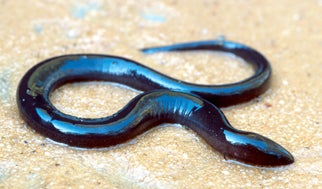SCIENTIFIC NAME:
Amphiuma pholeter Neill
OTHER NAMES:
None.
STATUS:
Rare, poorly known, and peripheral. Known from one locality each in Southern Coastal Plain and Southern Pine Plains and Hills. Potentially occurs in southern portion of Dougherty Plain. HIGH CONSERVATION CONCERN.
DESCRIPTION:
An elongate (up to 30 cm [12 in.] long), slender salamander, slightly more than width of a pencil in diameter. Unique among salamanders in possessing tiny, single-toed legs, one pair just behind the small gill opening at each side of neck and another pair just ahead of the longitudinal anal slit (Neill 1964a, Means 1996).Coloration uniformly dark brown dorsally and ventrally. Tail length about 22 percent of total length. Existence of larval stage unknown. Eggs and hatchlings undescribed. One of three species constituting an entire family whose fossil history extends back into the Cretaceous (more than 65 million years ago).
DISTRIBUTION:
Eastern Gulf Coast from about 50 kilometers (30 miles) north of Tampa, Florida, west to the Pascagoula River, Mississippi. Found primarily in swampy floodplains close to coast and not extending far inland. In Georgia, known only from lower Ochlocknee River drainage. In Alabama, known only from Baldwin and Mobile counties, but may be found in both southern Georgia and southern Alabama wherever suitable mucky habitats extend northward along major river floodplains from the Florida Panhandle, such as along the Mobile, Tensaw, Perdido, Conecuh, Choctawhatchee, Chipola, and Chattahoochee rivers.
HABITAT:
Deep, liquid, organic muck in alluvial swamps of larger streams, or, less commonly, in mucky habitats associated with small headwater brooks and seepages, especially in winter (Means 1977). The amorphous muck consists of decomposing organic litter that has lost its fibrous, leafy nature; derived from decaying leaves of bald cypressand bottomland hardwoods such as tupelos and sweetbay. These mucky sites are subject to periodic flooding and drying (Means 2000).
LIFE HISTORY AND ECOLOGY:
Eggs probably laid in summer, in peat under roots of vegetation growing adjacent to muck beds (Means, unpubl.). In captivity, very small young may reach adult size in two years (probably one year in nature). Food includes invertebrates that live in the muck: earthworms of the genera Sparganophilus and Diplocardia, aquatic insect larvae (odonates and dipterans), terrestrial beetles, and sphaeriid clams (Means, unpubl.). Potential predators include raccoon, feral pig, mud snake, common snapping turtle, musk turtle, and other species of Amphiuma. Must place snouts at surface of muck to breathe when muck is saturated, but remain in tunnels when muck dries during droughts.
BASIS FOR STATUS CLASSIFICATION:
This unique vertebrate is restricted to the lower eastern Gulf Coastal Plain, has a relatively small geographic distribution, and is confined to specialized wetland habitats. Considered rare in Florida, the state containing most of its distribution (Means 1992a). Because of the scarcity of suitable habitats, and the apparent restriction of these habitats to the Lower Coastal Plain, it is unlikely that the species ranges very far northward into Alabama and Georgia. Only two specimens, one each from southern Baldwin and Mobile Counties, have been found thus far in Alabama (Carey 1984, 1985).
Author: D. Bruce Means






